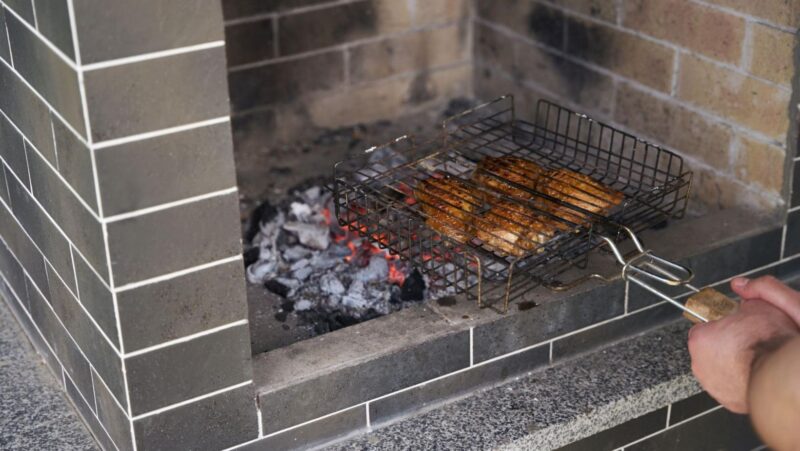
Keep your love for gardening alive all year by turning to a greenhouse for the cold months! With the right tweaks and smart moves, your greenhouse can bloom into a lush haven even when it’s freezing outside.
Can You Use a Greenhouse in the Winter?
Engaging in horticultural pursuits during the frigid months is not only possible but also exceptionally enjoyable. By selecting the optimal flora and executing a few strategic alterations, you can sustain a fertile cultivation space throughout the winter period.
The paramount consideration is ensuring the internal temperature of the conservatory remains above the freezing threshold, thus creating an ideal condition for your vegetation to flourish.
Winter Greenhouse types
Although most greenhouses can facilitate winter gardening to a certain extent, specific types are particularly good at enduring frigid temperatures and offering sufficient insulation. Here are the various greenhouse types that perform well during the cold season:
- Double-walled polyethene sheet greenhouses – economical and with easy access, these greenhouses are crafted with dual layers of plastic, creating an insulating air pocket between them. They are particularly well-suited for locales with mild winters.
- Double-walled glass greenhouses provide exceptional thermal insulation and are optimal for colder climates. The dual-pane design enhances thermal retention and efficiency, ensuring these structures are ideal for year-round gardening.
- Half-wood walled greenhouses – combining the advantages of wood with either polyethene or glass, these hybrid structures offer both insulation and structural integrity. They are an adaptable choice for regions with moderate to cold temperatures.
- Half-brick-walled greenhouses – while expensive to construct, brick-walled greenhouses deliver unmatched insulation, making them perfect for severe winter conditions. These robust and durable structures support year-round gardening in the harshest of climates.
How to Choose a Greenhouse
When selecting a greenhouse for winter gardening, focus on factors like insulation, structural robustness, and ventilation. Opt for a design featuring double-walled construction and a resilient frame capable of withstanding harsh weather.

Additionally, consider the greenhouse’s orientation to maximise solar exposure and minimise thermal loss. Ensure thorough sealing and insulation to prevent heat escape during cold periods.
How to Keep a Greenhouse Warm in Winter
Maintaining ideal temperature conditions within your greenhouse is crucial for fostering the vitality and development of your plants throughout the winter season. Here are three efficient strategies for heating a greenhouse:
- Black Water-Filled Barrel – position a black barrel with water within the greenhouse to absorb solar warmth throughout daylight hours and disperse it after dusk. The darkened plastic material absorbs sunlight, transmuting it into thermal energy, aiding in the maintenance of a consistent temperature.
- Electric Heater – implement an electric heating device equipped with a thermostat to oversee temperature regulation and prevent abrupt shifts. Opt for a heater with adequate capacity to effectively warm your greenhouse, factoring in its dimensions and insulation properties.
- Compost Bin – use a compost bin to generate warmth via the process of organic decomposition. Introduce natural elements such as wood chips, manure, and kitchen waste to the compost pile, periodically rotating it to facilitate decomposition and heat emission. Strategically position the compost bin within the confines of the greenhouse for uniform heat dispersion.
Furthermore, optimise sunlight absorption by enveloping the greenhouse floor and benches with black landscaping fabric and clearing snow from the roof to enable unhindered sunlight penetration. Additionally, contemplate enhancing greenhouse insulation by installing thermal curtains or bubble wrap to diminish nighttime heat dissipation.
What Vegetables Grow Perfect in a Winter Greenhouse
Harness the sheltered ambience of your greenhouse to nurture an assortment of cold-resistant vegetables. Below are several robust crops that flourish amidst wintry climates:
- Kale: an adaptable and resilient plant, able to endure frigid temperatures as low as -21°C. Opt for variations like curly kale or Lacinato kale for their sturdiness and savoury taste.
- Brussels Sprouts: these tiny cabbage-like vegetables ripen amidst late winter and the beginning of spring, yielding a plentiful harvest. Initiate the sprouting of seeds in the late spring or at the onset of summer and transplant them into a sheltered greenhouse on autumn’s arrival.
- Spinach: providing essential nutrients, spinach thrives during the winter months in unheated greenhouses. Select resilient strains such as ‘Winter Bloomsdale’ or ‘Giant Winter’ to maximize yields and quality.
- Potatoes: less resilient to extreme cold, potatoes can flourish within a sheltered environment like a greenhouse, provided there is sufficient insulation and safeguarding against frost. Plant early-season cultivars into sizable containers or cultivate them in grow bags filled with compost-enriched soil to facilitate an indoor potato yield.
- Winter Lettuces: varieties such as rocket and petite gem lettuce provide an array of crisp salad greens throughout the winter season. Implement a succession planting strategy to ensure a continuous yield while maintaining proper spacing and consistent irrigation. Additionally, to avoid issues with water quality that could affect your plants, schedule a backflow inspection for your irrigation system to ensure that the water used for your winter lettuce remains clean and free from contaminants, supporting their healthy growth throughout the season.
- Cabbage: initiate cabbage planting during the autumn months to have a crop ready for harvest by St. Patrick’s Day. Opt for compact types like ‘January King’ or ‘Savoy King’, which are renowned for their ability to withstand cold conditions and deliver exceptional taste.

- Broccoli: commence the growth of the plants in the latter part of autumn so they can be transplanted outdoors in the initial stage of spring. Opt for cold-resistant variants such as ‘Mauve Budding’ or ‘Waltham 29’ to foster their development in winter greenhouse environments.
- Bok Choi: thriving in cooler climates, this Asian vegetable reaches maturity within a matter of weeks, making it ideal for harvests during winter. Directly sow seeds in greenhouse soil or containers, ensuring adequate room for expansion and development.
Conclusion
Through the careful selection of robust crops and the application of efficient heating techniques, you can relish a plentiful winter yield, thus enhancing the greenhouse gardening venture to new heights. Embrace the enchantment of winter horticulture and nurture a thriving sanctuary of greenery even amidst the chilliest months of the year.







